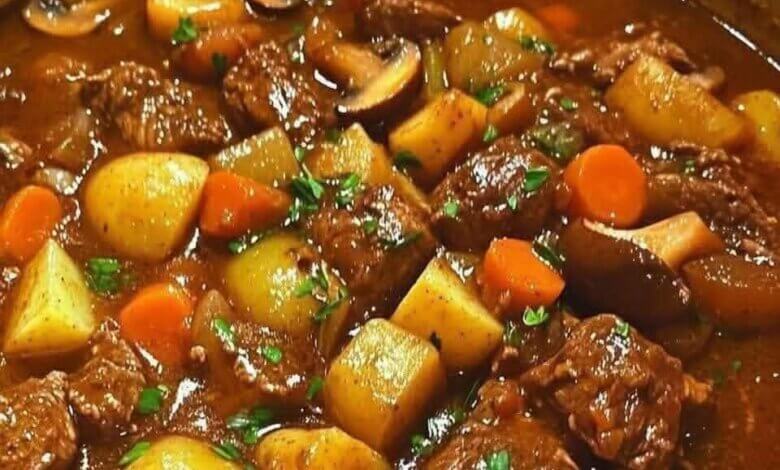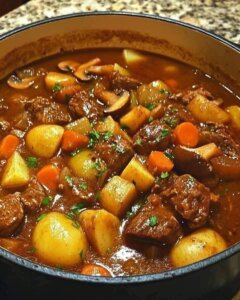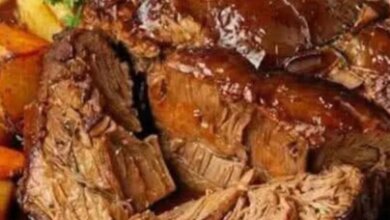OLD FASHIONED BEEF STEW

Introduction
Old-Fashioned Beef Stew is a timeless comfort dish loved across generations. With tender chunks of beef simmered slowly alongside hearty vegetables in a rich, savory broth, it offers warmth and nourishment in every spoonful. It’s a staple of family tables and gatherings, perfect for chilly days or whenever you crave something wholesome and satisfying.
—
Origin
Beef stew traces its roots to early European peasant cooking, where tougher cuts of meat were simmered slowly with root vegetables to create a filling meal. Versions exist worldwide — from French boeuf bourguignon to Irish stew — but the “old-fashioned” variety most often refers to the rustic American take, emphasizing simplicity and depth of flavor.
—
Cultural Significance
Beef stew has long been a symbol of comfort, hospitality, and togetherness. In many households, it’s a Sunday supper tradition or a way to stretch ingredients economically while still feeding a crowd. Its slow-cooked nature reflects patience and care, making it a beloved part of home cooking.
—
Ingredients & Quantities (Serves 6)
2 lbs (900 g) beef chuck, cut into 1½-inch cubes
3 tbsp all-purpose flour (for dredging)
2 tbsp vegetable oil or olive oil
4 cups beef broth (low-sodium)
1 cup dry red wine (optional, replace with broth if preferred)
2 tbsp tomato paste
1 tsp Worcestershire sauce
3 medium carrots, peeled and cut into chunks
3 medium potatoes, peeled and cut into cubes
2 celery stalks, sliced
1 large onion, chopped
3 cloves garlic, minced
1 tsp dried thyme (or 2 sprigs fresh thyme)
2 bay leaves
Salt and freshly ground black pepper, to taste
1 cup frozen peas (added at the end)
2 tbsp chopped fresh parsley (for garnish)
—
Optional Additions
Mushrooms for an earthy note
Turnips or parsnips for extra sweetness
A splash of balsamic vinegar for depth
A pinch of smoked paprika for subtle warmth
—
Tips for Success
Brown the beef well: Sear in batches to create rich flavor.
Deglaze the pot: Use wine or broth to lift browned bits — they add depth.
Low and slow: Simmer gently for 2–3 hours to ensure the beef is fork-tender.
Cut veggies evenly: Uniform pieces cook at the same rate.
Adjust thickness: If the broth is too thin, mix 1 tbsp cornstarch with cold water and stir it in near the end.
—
Instructions
1. Pat beef dry and toss with flour, salt, and pepper.
2. Heat oil in a large heavy pot or Dutch oven. Brown beef in batches; set aside.
3. In the same pot, sauté onions, celery, and garlic until fragrant. Stir in tomato paste and cook 1 minute.
4. Deglaze with wine (or broth), scraping up browned bits.
5. Return beef to the pot. Add broth, Worcestershire sauce, thyme, and bay leaves. Bring to a boil, then reduce to a gentle simmer. Cover and cook 1½–2 hours, stirring occasionally.
6. Add carrots and potatoes; cook another 30–40 minutes until vegetables and meat are tender.
7. Stir in peas during the last 5 minutes. Remove bay leaves.
8. Taste and adjust seasoning; garnish with parsley. Serve hot with crusty bread.
—
Description
This stew is thick, aromatic, and brimming with tender beef and vegetables enveloped in a savory, silky gravy. The long simmer develops deep, layered flavors — hearty enough to be a meal on its own.
—
Nutritional Information (per serving, approx.)
Calories: 400–450
Protein: 35 g
Carbohydrates: 25 g
Fat: 18 g
Fiber: 4 g
Sodium: 550 mg
(Values vary with ingredient choices.)
—
Conclusion
Old-Fashioned Beef Stew isn’t just food; it’s a culinary tradition that celebrates warmth, simplicity, and the pleasure of sharing a meal. Its humble ingredients, slow preparation, and hearty result remind us of the value of time spent in the kitchen.
—
Recommendation
Pair your stew with crusty bread, a light green salad, or a glass of red wine. Make a large batch — it tastes even better the next day as flavors meld.
—
Embracing Healthful Indulgence
Enjoy this stew as part of a balanced diet by trimming visible fat from the beef, using low-sodium broth, and loading it with colorful vegetables. Savor it mindfully — every spoonful offers a comforting, nutrient-rich indulgence.



